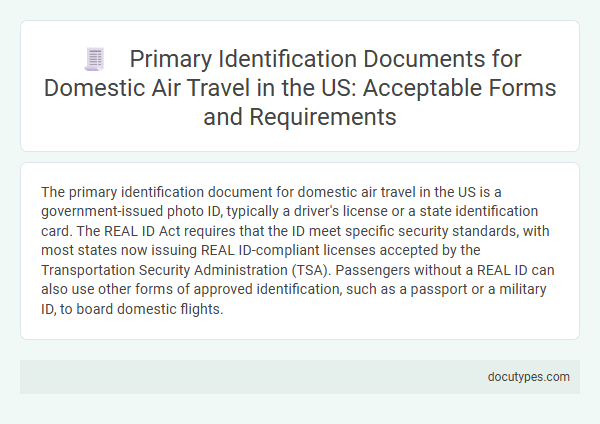The primary identification document for domestic air travel in the US is a government-issued photo ID, typically a driver's license or a state identification card. The REAL ID Act requires that the ID meet specific security standards, with most states now issuing REAL ID-compliant licenses accepted by the Transportation Security Administration (TSA). Passengers without a REAL ID can also use other forms of approved identification, such as a passport or a military ID, to board domestic flights.
Introduction to Primary Identification for Domestic Air Travel
Primary identification is essential for domestic air travel within the United States to verify your identity securely. The Transportation Security Administration (TSA) mandates appropriate ID to ensure safety and streamline airport security procedures.
- Real ID Driver's License - Serves as the standard acceptable form of identification for domestic flights starting from May 2025.
- U.S. Passport - Valid for both domestic and international air travel as a government-issued photo ID.
- Other TSA-Approved IDs - Includes state-issued enhanced driver's licenses, military IDs, and federally recognized tribal IDs acceptable at airport checkpoints.
Overview of TSA Identification Requirements
The primary identification document for domestic air travel in the United States is a government-issued photo ID that complies with TSA requirements. The Transportation Security Administration (TSA) mandates specific ID standards to ensure passenger identity verification and security at airport checkpoints.
- Acceptable IDs include state-issued driver's licenses and identification cards - These documents must be REAL ID-compliant by the enforcement deadline set by the Department of Homeland Security.
- U.S. passports and passport cards are valid for domestic flights - These serve as proof of identity and citizenship recognized by TSA.
- Non-compliant IDs may result in additional screening - TSA officers may request alternative forms of identification or require further verification before allowing boarding.
REAL ID Act: What Travelers Need to Know
The primary identification document for domestic air travel in the US is a REAL ID-compliant driver's license or state-issued identification card. The REAL ID Act, implemented to enhance security, sets federal standards for these IDs.
Starting May 7, 2025, all air travelers must present a REAL ID-compliant document or an accepted alternative such as a passport. Non-compliant IDs will no longer be accepted for boarding federally regulated commercial aircraft.
Valid State-Issued Driver’s Licenses and Identification Cards
What is the primary identification document required for domestic air travel in the US? Valid state-issued driver's licenses and identification cards serve as the main form of ID accepted at airport security checkpoints. Your driver's license or state ID must comply with the REAL ID Act standards to be accepted for boarding.
US Passport and US Passport Card for Domestic Flights
The primary identification document for domestic air travel in the US is a government-issued photo ID. The most widely accepted documents include the US Passport and the US Passport Card.
The US Passport provides full international and domestic identification and is accepted at all TSA checkpoints. The US Passport Card is a convenient, wallet-sized alternative valid for domestic flights and land or sea travel to Canada, Mexico, and the Caribbean. You must ensure your ID is current and meets TSA requirements before traveling.
Federal Identification: Military and Government IDs
The primary identification documents accepted for domestic air travel in the US include federal identification such as military and government-issued IDs. Military IDs are issued to active duty personnel, retirees, and eligible dependents, serving as valid proof of identity at TSA checkpoints. Your government ID, including federal employee identification cards, also meets TSA requirements for boarding domestic flights.
Tribal Identification Cards as Accepted Documents
The primary identification document for domestic air travel in the US is a valid government-issued photo ID. Tribal Identification Cards issued by federally recognized tribes are accepted by the Transportation Security Administration (TSA) as valid identification at airport security checkpoints. You can use a Tribal ID to verify your identity when flying within the country, ensuring a smooth travel experience.
Alternative Forms of Acceptable Identification
The primary identification document for domestic air travel in the US is a Real ID-compliant driver's license or state ID. These IDs meet federal standards set by the Department of Homeland Security for airport security verification.
Alternative forms of acceptable identification include a U.S. passport, passport card, or DHS trusted traveler cards such as Global Entry, NEXUS, or SENTRI. Other options are military IDs, permanent resident cards, and border crossing cards, which are valid for TSA screening purposes.
Requirements for Minors and Special Circumstances
The primary identification document for domestic air travel in the US is typically a government-issued photo ID. Minors and travelers with special circumstances have specific guidelines to follow to meet TSA requirements.
- Adult Travelers - A valid state-issued driver's license or passport is required for adults 18 and older.
- Minors Under 18 - Generally, minors are not required to provide identification when traveling with an adult companion within the US.
- Special Circumstances - Travelers without standard IDs may use alternative documents such as a birth certificate, social security card, or TSA's identity verification process.
Your airline may have additional policies, so verify identification requirements before traveling.
What Is the Primary Identification Document for Domestic Air Travel in the US? Infographic

